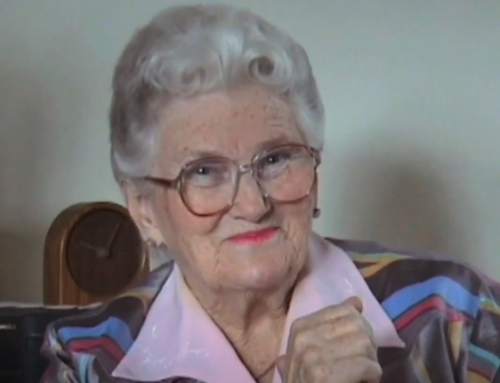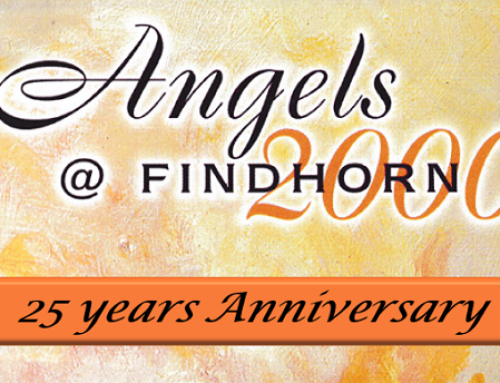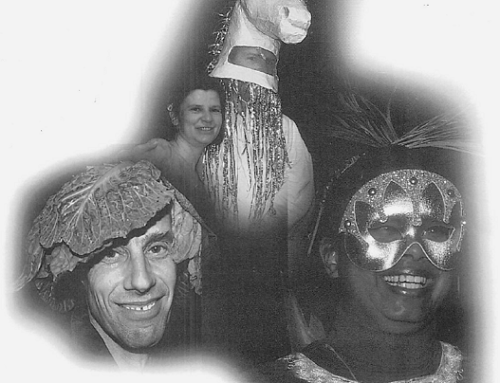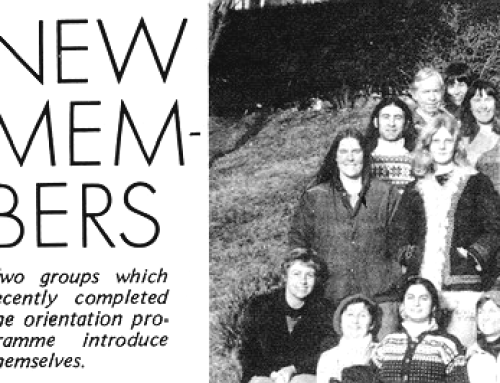The 3rd World Wilderness Congress (3rd WWC) convened in October, 1983 in Inverness, and Findhorn with 600 delegates from 25 countries.
The event had a very special impact on the Community as it provided the deadline for completing the Universal Hall, a story told by Caroline Shaw. But of course the content of the conference also shaped the Community’s future, as all conferences at Findhorn have played a formative role in the evolution of the Community over the years.
The Congress discussed questions such as
- Why is wilderness an essential element of a healthy and sane world?
- What are the cultural, spiritual and biological benefits of wilderness?
- What responsibilities, actions and policies are needed to create the best human-nature relationship?
- How can we balance the needs of individuals, society and the Earth itself in order to assure that wild places will remain a functioning and valuable part of our planet?
 The wilderness issue was explored in depth by a multi-disciplinary gathering of scientists, artists, politicians, industrialists, tribal people, psychologists and philosophers. A book was published on the proceedings of the conference, Wilderness – The Way Ahead, edited by Vance Martin and Mary Inglis, published by Findhorn & Lorian Press, 1984 (full text is available here).
The wilderness issue was explored in depth by a multi-disciplinary gathering of scientists, artists, politicians, industrialists, tribal people, psychologists and philosophers. A book was published on the proceedings of the conference, Wilderness – The Way Ahead, edited by Vance Martin and Mary Inglis, published by Findhorn & Lorian Press, 1984 (full text is available here).
According to Ian Player the 3rd WWC was difficult to organise. With the Findhorn Foundation yet to establish itself as a mainstream conference centre, raising money in the UK proved challenging; the first donation of £50 arrived after a year of fundraising had passed. Delegates were slow to register and some speakers took months to reply. The support of many environmentalists across the world, and a commitment to the enormous importance of the subject, kept the project going. The first day of the Congress welcomed a capacity number of delegates, with many potential speakers and delegates unfortunately having to be turned away.
We are pleased to have the audio recordings of some of the presentations and list them at the end of the post.
Some of the Presenters
Ian Player (1927-2014) was a South African conservationist at a time when Africa’s protected areas were being created. With his team, he pioneered to save from extinction the highly-endangered Southern white rhino. He insisted that matters of spirit were as important in conservation as science and that people and their cultures are an important part of the environmental equation. His talk at the conference was entitled ‘Wilderness: Trail to the Future’. He described how the wilderness in South Africa had been reduced to tiny pitiful remnants of what had once been the huge wild area of southern Africa, and the steps that he and his associates had taken, often enduring unthinkable persecution as a result, to strengthen protection and thus mitigate against further damage.
Sir Laurens van der Post (1906-1996) was a well-known figure in the development of the Wilderness movement and close friend of Ian Player. Sir Laurens was noted for his interest in Carl Jung. When Player read Laurens’s biography of Jung in the 1970s, he became a passionate Jungian which led him to found a Jungian centre in South Africa, in close association with Sir Laurens. Sir Laurens’ political connections proved useful when Player was organising the first World Wilderness Congress in Johannesburg in 1977. Their joint interest in the mysticism of Jung perhaps influenced their decision to hold the 3rd World Wilderness Congress at Findhorn. Sir Laurens was also the founding patron of the Gaia Foundation. He was well known for his relationships with notable figures, such as King Charles III, (he was godfather to Prince William), and the British Prime Minister Margaret Thatcher.
He was at the height of his fame when he gave the presentation ‘Wilderness: A Way of Truth’ at the conference, in which he encouraged the audience to discover, and give expression to, their ‘inner wilderness’. After his death, there was controversy over claims that he had exaggerated some aspects of his life, and an unsubstantiated assertion that early in his adult life that he had fathered the child of an underage girl left in his care.
Jean Balfour (1927-2023) served as chair of the Countryside Commission for Scotland (1972-83) and was involved in forestry, land management and agriculture. She made biological expeditions to many places, including Greenland and arctic Siberia. She was governor of East Scotland College of Agriculture for 30 years and deputy chair of a cabinet committee on women in science, engineering and technology. She was made CBE in 1981 and received the Institute of Chartered Foresters Medal for services to British Forestry in 1996. Her talk at the conference was entitled, ‘Some Aspects of the Scottish Countryside’. She emphasised the relationship and tension between the people and the land in Scotland, the depleted countryside and the development of tourism threatening local ecosystems.
Dorothy Maclean (1920-2020) Dorothy was one of the original founders of the Findhorn community, along with Eileen and Peter Caddy and Lena Lamont. Her talk at the conference was entitled ‘The Essence of Nature’. She described how in meditation it came to her the need to attune to nature, and to harmonise with the intelligence of nature. She explored the dimensions of her inner self, experiencing each as an energy field, associated with a particular species of plant life in the Findhorn garden. She spoke at length about the energy field of the tree, and its specific need to cover the surface of the earth like a skin, protecting and nourishing all of life. She stressed the importance of wilderness as encompassing nature forces at their strongest. Hers was likely the first-ever presentation at a global environmental conference of the reality of the spiritual beings with which we can collaborate in our work with nature.
Sir George Trevelyan (1906-1996) Sir George gave a talk at the conference entitled ‘A Spiritual Vision for Nature and Society’. He described the universe as a living oneness and invited the audience to engage in a guided meditation to expand its consciousness through use of the imagination. He maintained that self-consciousness can take a leap into cosmic consciousness and that we can become part of nature and not separate from it. This he describes as having been the vision of mystics throughout millennia. He likens human beings going off in their own reckless ways to be similar to a cancer spreading across the earth. This could lead to mass extinction but he urges the audience to recognise that change is taking place and that we are discovering our true natures. This he maintains is nature becoming conscious of itself. For Sir George, the conservation of wilderness is inseparable from spiritual vision.
Vance Martin was the focaliser of the conference, the Secretariat of which was based at Cullerne House with Tracey Barton as administrative assistant. Vance is an expert in international nature conservation and wilderness protection, a writer and story-teller. He works at all levels – government, business, community, traditional/Indigenous, and specialises in bridging the interests of people and nature through culture, communications, science, and policy. He was president of the WILD Foundation from 1984 to 2023, an international conservation organisation explicitly dedicated to protecting wilderness, connecting wild nature to people, and to communicating the values of wilderness and its benefits for human communities. He was a long-term member of the Community, amongst many other responsibilities, he was the at one time focaliser of the Core Group, the Garden, and a long-term coordinator of the environmental programmes.
Audio recordings of some of the presentations
Opening with Ian Player and Morton Boyd
Opening with Government Speakers
Alan Grainger Forests and Their Role in the Future of World Civilisation
Felipe Benavides From the Incas to C.I.T.E.S (Peru’s Wildlife and Conservation Mercenaries)
Barry Cohen The Franklin Saga – Tasmanian Hydro Scheme
Ramakrishna Palat The Silent Valley Story, Don Richards The Use of Wilderness and Environmental Studies across the School Curriculum
Franco Zunino A Wilderness Concept for Nature, Sally Ranney Working to Conserve Wild America: The Wilderness Movement in the US
Anthony Fairclough Wilderness in the European Community
John Block Evolution of the Wilderness Concept in the US
Sheldon Campbell Restocking the Wilderness with Captive-Bred Animals: The Californian Condor Story
Ian Macphail Whither World Wilderness, Carolyn Tawangyawma Human Rights Within Natural Law
C.A. Meier Wilderness and the Search for the Soul of Modern Man
Dorothy Maclean The Essence of Nature
Gordon Strachan The Bible: An Ecological Perspective
Joan Price Sacred Lands are a Source of Balance, Panel
Karen Blair The Value of Wilderness for Young People of Today and Tomorrow
Ian Player reflections, Laurens van der Post Wilderness: A Way of Truth
Roger Pope Energy and Environment: Preserving a Delicate Balance, Jean Balfour Some Aspects of the Scottish Countryside Adam Watson Wilderness Values and Threats to Wilderness in the Cairngorms
Robert Cowan Human Nature
Morton Boyd Edge of the World: Fraser Darling’s Islands
Hans Anderson Tundra Taiga Forests of Siberia and Lappland
Loening Conservation efforts in Bulgaria, Kedenehe a Native American Indian audiovisual presentation
Steinmann Cape York Queensland
Panel Discussion
Summing Up Vance Martin Ian Player
Congress Resolutions

I first visited Findhorn in 1979 and came back regularly before buying my caravan when I retired in 2019. I worked as Director of an NHS Training School running a clinical and doctorate programme.











Leave A Comment